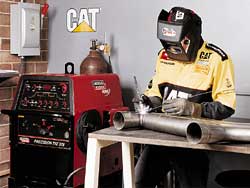Precision TIG Series 4: Rated Output
In recent issues of Lincoln's i-Weld newsletter, we have focused on the attributes of the Precision TIG® 275 and 375 welding units. We have illustrated the machine's superior arc performance, innovative value features and ease in set-up. This time, we turn our attention to the Precision TIG's low input current draw, its ability to provide the highest rated output, and its broader amperage range compared to its nearest competitor. For customers, this means more output versatility with the lowest input current draw
In designing the new Precision TIG®, Lincoln wanted to find out what customers really wanted in a TIG machine. To do this, a team of engineers held extensive interviews with customers, distributors and sales personnel to put together a 'wish list' of items that welding operators and company management would like to see.
During these interviews, it was noted that customers wanted a versatile machine that could deliver a wide amperage range to tackle the thinnest material up to heavier weldments. High input current draw was also a concern, especially in fabrication shops that utilized 208v input power. Some customers stated that, with the competitive TIG welders they were currently using, they needed to shut off other equipment in order to weld without tripping circuit breakers.
Taking these concerns under consideration, the Precision TIG® was designed to provide a higher rated output compared to competitive models. The Precision TIG®, featuring Micro-Start Technology™, also has the ability to weld down to lower currents than its competition. Finally, the Precision TIG® draws less current at comparable output levels. This means the Precision TIG® is the unit of choice when it comes to output capability with low current draw.
Review the Numbers for Yourself
As an example of the benefits provided by the Precision TIG®, compare the output ratings of the two Precision TIG® models with those of their nearest competitors, the Syncrowave models from Miller Electric Manufacturing, Inc®.
|
Output |
Lincoln Precision TIG 275 |
Miller Syncrowave® 250DX |
Lincoln Advantage |
|
40% Duty Cycle Rating |
275 Amps @ 31V |
250 Amps @ 30V |
More Output! |
|
Amperage Range |
2-340 Amps |
5-310 Amps |
Wider Range! |
|
Output |
Lincoln Precision TIG 375 |
Miller Syncrowave® 350LX |
Lincoln Advantage |
|
40% Duty Cycle Rating |
375 Amps @ 35V |
350 Amps @ 34V |
More Output! |
|
Amperage Range |
2-420 Amps |
3-400 Amps |
Wider Range! |
The Precision TIG® delivers 25 more amps of output at the same duty cycle and in addition, the Precision TIG® delivers an overall wider amperage range.
Now compare the Precision TIG® 275's input current draw at the same output amperage level to the Syncrowave 250DX:
Precision TIG® 275 Current Draw Competitive Comparison
| Input |
Precision TIG 275
|
Syncrowave 250DX
|
Advantage Lincoln
|
| Output Setting @ 28 VAC |
200A
|
200A
|
|
| Duty Cycle |
100%
|
60%
|
More Duty Cycle!
|
| 230V |
70 Amps
|
77 Amps
|
Less Current Draw
|
| 460V |
35 Amps
|
38 Amps
|
Less Current Draw
|
| 575V |
28 Amps
|
31 Amps
|
Less Current Draw
|
The Syncrowave 250DX draws up to 10% higher input current and delivers 40% less duty cycle (based on available literature at the time of this printing).
Precision TIG® 375 Current Draw Competitive Comparison
| Input |
Precision TIG 375
(With Standard Power Factor Capacitors) |
Syncrowave 350LX
(With Optional Power Factor Capacitors) |
Advantage Lincoln
|
| Output Setting @ 32VAC |
300A
|
300A
|
|
| Duty Cycle |
100%
|
60%
|
More Duty Cycle
|
| 230V |
72 Amps
|
85 Amps
|
Less Current Draw
|
| 460V |
36 Amps
|
43 Amps
|
Less Current Draw
|
| 575V |
29 Amps
|
34 Amps
|
Less Current Draw
|
The Syncrowave 350LX draws almost 20% higher input current draw and delivers 40% less duty cycle (based on available literature at the time of this printing).
Conclusion
Looking for a TIG machine that will draw lower input current, deliver more output power, plus offer the widest operating range for maximum versatility? Then look no further than the new Precison TIG® family of TIG welders from Lincoln Electric.

